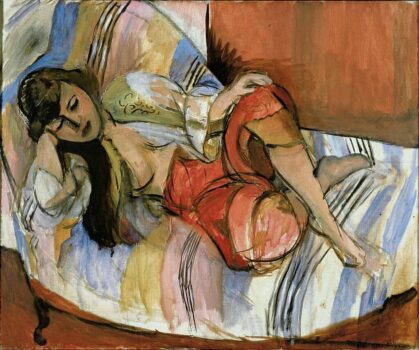Henri Matisse’s Most Famous Paintings
In the world of modern art, few names resonate with as much color, creativity, and innovation as Henri Matisse. Known for his bold use of color, expressive forms, and relentless experimentation, Matisse reshaped the visual language of painting in the 20th century. His legacy is as vibrant and captivating as the canvases he left behind.
The Life of Henri Matisse: A Journey into Color
Henri Matisse was born on December 31, 1869, in Le Cateau-Cambrésis, a small town in northern France. Initially studying law, Matisse’s life took a dramatic turn when he fell ill and began painting during his convalescence. That brush with illness turned out to be a fateful one, it awakened in him a lifelong passion for art.
By 1891, Matisse moved to Paris to formally study art at the Académie Julian and later under Gustave Moreau at the École des Beaux-Arts. Though he began with a classical education, Matisse quickly broke away from academic constraints. He absorbed inspiration from Impressionism, Post-Impressionism, and Islamic art, ultimately carving a unique and revolutionary style of his own.
What Was Henri Matisse Known For?
Henri Matisse is most famously known for his mastery of color, form, and decorative abstraction. He is one of the leading figures of Fauvism, a movement characterized by its use of wild brushwork and vivid colors. Unlike the Impressionists, who were concerned with capturing light and naturalism, Matisse used color as a tool of emotional expression.
His works were not merely representational, they were experiences. He believed that art should be “a soothing, calming influence on the mind, something like a good armchair,” a radical notion that celebrated beauty, joy, and emotional clarity over intellectualism or harsh realism.
How Did Henri Matisse Make His Paintings?
Matisse was a relentless experimenter. His process evolved over the years, and his techniques were as diverse as his subjects.
1. Bold Color and Simplified Forms
In his early career, particularly during the Fauvist period (early 1900s), Matisse used non-naturalistic colors applied in large, flat swaths. He abandoned shading and perspective in favor of intense contrasts and fluid shapes.
2. Drawing with Scissors
Later in life, especially in the 1940s when he was battling illness, Matisse pioneered the cut-out technique, which he described as “drawing with scissors.” He would cut shapes from painted paper and arrange them into vibrant collages. Works like The Snail and Blue Nude II emerged from this period, showcasing his mastery of form even without traditional brushwork.
3. Decorative Composition
Matisse often arranged his compositions like tapestries. Whether it was a still life, a portrait, or a room interior, his canvases emphasized ornamental patterns and harmonious rhythms. He often painted from memory or imagination, creating works that straddled the line between abstraction and figuration.
What Art Style Is Henri Matisse Associated With?
Henri Matisse is most closely associated with Fauvism, a short-lived but powerful movement that challenged traditional art norms. The Fauves (French for “wild beasts”) shocked critics in 1905 with their use of intense color and distorted forms. Though the movement dissipated within a few years, Matisse’s style continued to evolve in ever-bolder directions.
Aside from Fauvism, Matisse’s later works anticipate the development of Abstract Expressionism and Color Field painting. His influence can be seen in artists like Mark Rothko, David Hockney, and Ellsworth Kelly.
What Materials Did Henri Matisse Use?
Matisse worked across a variety of media throughout his long and prolific career:
1. Oil Paint
His Fauvist masterpieces, portraits, and early still lifes were primarily done in oil on canvas. He used bright pigments and avoided heavy modeling.
2. Gouache and Paper
In his later years, Matisse turned to gouache-painted paper for his cut-outs. He had assistants paint sheets of paper in specific hues, which he then cut and assembled into dynamic compositions.
3. Charcoal and Ink
Matisse’s drawings, such as his Themes and Variations series, were often executed in charcoal or black ink. These works demonstrated his confidence in line and contour.
4. Stained Glass
Late in life, Matisse designed the stunning Chapelle du Rosaire in Vence, France. This included stained-glass windows, tapestries, and murals, bringing together light, color, and sacred space in a deeply personal artistic achievement.
Henri Matisse’s Famous Paintings
Matisse created hundreds of paintings, but a few stand as iconic testaments to his genius:
1. Woman with a Hat (1905)
This portrait of Matisse’s wife, Amélie, became a lightning rod of criticism and fascination when first exhibited. With its riotous colors and loose brushwork, it marked the public birth of Fauvism.
2. The Joy of Life (1905–06)
A sprawling canvas of nude figures in a fantastical landscape, this painting exemplifies Matisse’s ideal of harmony and sensual pleasure.
3. Red Room (Harmony in Red) (1908)
This masterpiece distills interior space into a nearly abstract arrangement of red, pattern, and rhythm. The wallpaper, tablecloth, and background all merge into a single decorative surface.
4. Dance (1910)
Commissioned by Russian collector Sergei Shchukin, Dance shows five nude figures in a circle, caught in an ecstatic motion. It’s a tribute to primal energy and unity, rendered in raw, emotive color.
5. Blue Nude II (1952)
Part of his famous cut-out series, this work demonstrates Matisse’s late style: simplified, sensual, and powerful.
6. The Snail (1953)
One of his largest cut-outs, The Snail is a kaleidoscopic spiral of color blocks that both simplifies and intensifies the idea of a snail’s shell.
How Many Paintings Did Henri Matisse Create?
Estimates suggest that Henri Matisse created over 1,000 paintings, alongside thousands of drawings, prints, and cut-outs. His body of work is vast and encompasses:
Paintings
Sculptures
Drawings
Lithographs
Book illustrations (e.g., Jazz, 1947)
Decorative designs (e.g., Chapel of the Rosary)
Many of his lesser-known works are in private collections or remain part of family estates, while others are housed in prominent museums worldwide.
How Much Do Henri Matisse Paintings Cost?
Henri Matisse’s works are highly prized on the art market. Depending on the size, medium, provenance, and period, his works can range from hundreds of thousands to tens of millions of dollars.
Record Prices:
“Les coucous, tapis bleu et rose” (1911) sold for $46.4 million at Christie’s in 2009.
“Odalisque couchée aux magnolias” (1923) sold for $80.8 million in 2018.
Works from his Fauvist period and late cut-out works tend to command the highest prices. Smaller drawings or lithographs, however, can be purchased for considerably less, making Matisse accessible even to mid-tier collectors.
Where Are Henri Matisse’s Paintings Located?
Matisse’s work is housed in major museums and collections across the globe. Some of the key institutions include:
1. Musée Matisse (Nice, France)
Located in the Cimiez neighborhood, this museum holds one of the largest collections of his paintings, drawings, and personal artifacts.
2. Musée Matisse (Le Cateau-Cambrésis)
Situated in his birthplace, this museum provides a comprehensive view of Matisse’s career and evolution.
3. Museum of Modern Art (MoMA), New York
MoMA owns many of Matisse’s greatest hits, including The Red Studio and Dance (I).
4. Hermitage Museum, St. Petersburg
Home to several works, including the monumental Dance II.
5. Tate Modern, London
Houses a substantial number of paintings and his famous cut-outs.
6. Centre Pompidou, Paris
Boasts a robust collection of Fauvist and post-Fauvist works.
7. The Barnes Foundation, Philadelphia
Contains a significant number of Matisse’s works, thanks to collector Albert C. Barnes.
In addition, many of his works reside in private collections and are often lent out for exhibitions around the world.
Matisse’s Enduring Influence
Henri Matisse passed away on November 3, 1954, but his artistic vision continues to inspire generations of artists. His emphasis on color, simplicity, and joy remains revolutionary even today. Unlike many modernist pioneers who embraced fragmentation and angst, Matisse offered a luminous counterpoint, an art of pleasure, serenity, and pure expression.
His late works, especially the cut-outs, are now considered precursors to minimalism and installation art. His boldness with color helped shape the trajectory of modernism in the 20th century and continues to influence art, design, and fashion.
Henri Matisse is not just a painter, he is a force of artistic liberation. His work asks viewers to feel rather than analyze, to find delight in a burst of color, a sweep of form, or a playful composition. In a world often marked by complexity and chaos, Matisse’s art offers something rare: clarity, joy, and an unshakable love for beauty.
Whether in the fluid limbs of dancers, the stillness of a red room, or the energetic abstraction of a paper cut-out, Matisse’s work whispers to us across time: “Art should be something like a good armchair in which to rest from physical fatigue.”
And for that, we are forever grateful.




